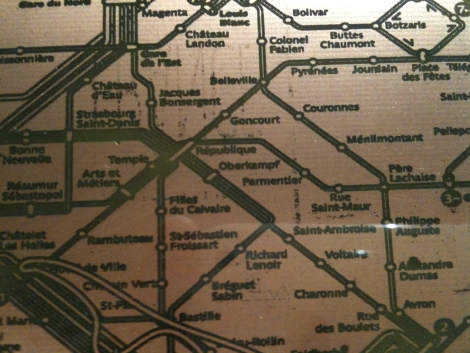
[Martin] had been using standard perf board for most of his electronics projects, but as he was starting to utilize more surface mount ICs, he quickly realized that it was time to start making his own PCBs. Having never etched any PCBs using the toner transfer method, he figured it was as good a time as any to give it a try.
Rather than make a board for a particular project, he decided to try his hand at etching a very detailed map of the Paris Metro as a test pattern instead. He grabbed a large image of the subway map, then printed it out on the back of a supermarket flyer. He attached it to his PCB and ran it through a lamination machine to transfer the toner. He figured that the laminator would be easier than an iron to use, and was right for the most part. The only issue he had was that the laminator did not generate enough heat, so he supplemented the its heat output with a hair dryer.
When everything was said and done, he had a pretty good looking PCB on his hands. Most of the Metro tracks and text came out just fine, though he admits there is a bit of room for improvement. It looks nice when mounted in a frame, though we would love to see a functional circuit made out of a PCB map like that. Heck, we’d even settle for a double-sided PCB with a street-level map on one side an the Metro on the other!















Hm. I think this could be used for printmaking…
http://mechanicrobotic.files.wordpress.com/2007/07/new-york-subway-map-of-the-internet.gif
I’m gunna give this a shot.
Yep, now onto the intaglio printing of US money!
The most interesting question is:
Is it still a useful board for an electronic schematic? Can you build a gadget with it?
apexys
if you actually isolated the overpass/underpasses, i don’t see why not. you could recreate the city, water tower made of capacitor or transistor, depending on what kind of water tower your city has, build your city into a circuit and see what your forefathers had secretly imagined
@Apexys: one idea would be to put surface mount LEDs on stations and light them red/green depending the traffic conditions (yes, there are traffic jams in the subway too…). But then lighting them individually would be difficult. Monitoring the state of a line would be much easier. Also I’m not sure if there is a nice webservice for this so this would require website parsing or such.
Does this only work with a laser printer? Or will this work with an inkjet as well?
Sweet, its like hacker scrimshaw.
Thumbs up on minimizing the amount of copper to etch. Doing so reduces the amount of copper drained on to the sea dramatically (95%+) and keeps etchant solution prices down.
@mrshko only a laser printer. The toner they use is a thermoplastic that can be melted off the page and onto another surface using heat — an inkjet uses water-based pigment inks that absorb into the paper and have no chance of working the same way.
sublimation ink can be transfered with heat and thats used in inkjet printers that might work just have to backwards
i have sublimaion ink will test
this is my first post but i been vewing this site for a while now
@Roberto – Most waste water processing plants reclaim the heavy metals from the water. Check with your local township before dumping Ferric Chloride down the drain though. Definitely do not pour it down the drain if you have a septic.
Standard laminators don’t get anywhere near hot enough to do this properly. You want to perform a mod, like the following:
http://ultrakeet.com.au/index.php?id=article&name=superfuser
I’ve made one of these, and it’s astonishingly good.
Thanks for showing us, i was planning on etching a board for the first time next week. Thank you for confirming the method i had in mind :)
The Paris Metro map is based on that of the London Underground, which was designed by a man called Harry Beck. Guess what – Harry was an electrical engineer. Wiki claims it wasn’t based on circuit schematic diagrams, but pretty much everyone else believes he did.
If you have an inkjet printer, just go down the photo-etch route. It produces more detail than toner transfer, and there are fewer gaps. An ordinary haloge or fluorescent lamp can be used as a UV source, or even the sun.
thanks @macw! I’m looking forward to trying this… I guess this would work with a xerox/copy then too?
@Mike – The toner transfer method can yield track and clearances down to 0.005″ if you use the right materials and etching techniques ;-) This is the processes I use: http://www.pcbfx.com/main_site/pages/start_here/overview.html All of the info is there, you just need some time to read it all.